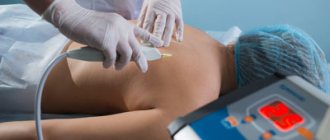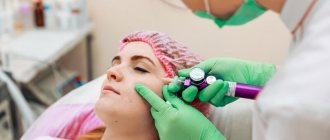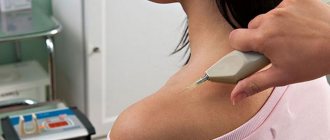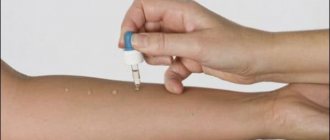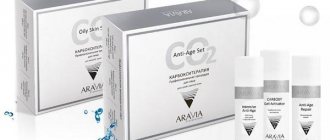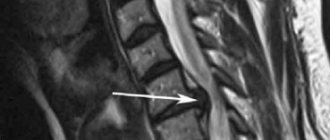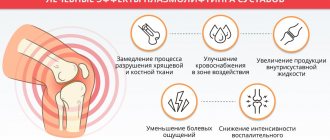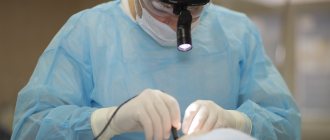The essence of the method
Degenerative-dystrophic changes in cartilage tissue and vertebrae provoke pain. Typically, pathological changes occur due to hypoxia (lack of oxygen), as well as a deficiency of nutrients in tissues due to excessive stress or metabolic disorders. As a result, the muscles become denser, tense, spasms and painful sensations occur. Carboxytherapy for the back and joints is a new treatment method using carbon dioxide. During the procedure, the doctor injects medical carbon dioxide into the joints or muscles of the back near the spine using a special device. After the injection, capillaries expand, blood flow increases, and metabolism accelerates.
Help: Even after the first session of carboxytherapy, the functionality of the body increases, cells and tissues are saturated with nutrients, pain and spasm disappear, and immune defense is activated. Weakened cartilage, blood vessels, and nerve processes are supplied with oxygen, and the symptoms of degenerative disorders become less pronounced. After the procedure, the development of pathology slows down. Carboxytherapy is carried out using special equipment. This device is designed to gently introduce carbon dioxide. Don’t worry, a purified substance is used during the session, which is confirmed by quality certificates. CO2 is not dangerous to the body, it is eliminated in 10-15 minutes.
Carboxytherapy for joints
Carboxytherapy for joints is actively used in clinics and health centers in Europe along with treatment with mineral waters. The procedure is based on the effect of active carbon dioxide molecules on the spine and joints. With the introduction of a certain volume of CO2, their mobility increases and the pain syndrome caused by a number of degenerative diseases of cartilage and bone tissue is partially or completely relieved.
Gas injections, which have a bactericidal and anti-inflammatory effect, are performed by a certified cosmetologist using a diffusion gun equipped with a sterile needle and thin nozzles, making the treatment of joints with carbon dioxide almost painless.
Who is it suitable for?
Carboxytherapy is a method of prevention and treatment of diseases affecting the musculoskeletal system, which is suitable for any patient who has no contraindications:
- heart diseases;
- skin rashes;
- chronic liver diseases;
- problems with the respiratory system;
- oncology;
- pregnancy and subsequent lactation.
Indications for the procedure
Carboxytherapy is used to treat joints. It is aimed at eliminating problems of the musculoskeletal system, including:
- arthritis and arthrosis;
- inflammation and dystrophic changes in ligaments;
- rheumatism;
- degenerative destruction of intervertebral discs, including osteochondrosis, as well as protrusion or hernia;
- vestibular disorders;
- regular pain symptoms in the back and joints.
Gas injections are sometimes used to treat diseases in neurology (migraine), phlebology (varicose veins) and urology or gynecology (relieving inflammation of organs located in the pelvic area). The procedure helps to recover from excessive stress and injuries in sports.
Adverse reactions and possible complications
Carboxytherapy for the treatment of joints is absolutely safe - allergic reactions or possible complications are practically excluded! The fact is that carbon dioxide is already involved in many biological and chemical processes in the body. Its excess after the procedure is eliminated through the kidneys and lungs in literally 10-20 minutes. A carboxytherapy session is often prescribed to patients who are prohibited from standard drug treatment. The fact that there are no contraindications is fully confirmed by reviews from clients who have undergone the procedure!
How does it work?
Joint pain occurs due to a lack of oxygen in the tissues and cells of the body (ischemia). This is caused by physical inactivity, sedentary work, and disturbances in blood or lymph microcirculation. With oxygen starvation, the muscles “clog” and tissue compaction occurs, which causes pain.
The carboxytherapy procedure increases oxygen starvation of cells, which immediately leads to a significant expansion of capillaries and increased blood flow to the problem area. It brings with it additional oxygen and saturates the body cells with it. After carboxytherapy, its concentration in adjacent tissues increases approximately 3 times. This activates the body and it begins to recover:
- joint inflammation is relieved;
- vegetative tension decreases;
- metabolism returns to normal, which helps eliminate waste and toxins;
- microcirculation of capillary blood and lymph exchange are optimized;
- pain syndrome disappears;
- Muscle tension is relieved, swelling and spasms go away.
Carbon dioxide is injected under the skin directly into problem areas of the joints and spine, for example, into adjacent spasmodic muscles, as well as into reflex points.
Video of the carboxytherapy procedure with the INDAP INSUF device:
Carboxytherapy procedure on the elbow joint
Carboxytherapy procedure on the knee joint
Frequency of the procedure
On average, the course is 5-12 injections, but its duration is determined individually. For example, carboxytherapy for osteochondrosis is carried out 1-3 times a week for a month, depending on the severity of the pain syndrome.
You can buy or rent temporarily (Moscow and the Moscow region) a device for treating diseases using the carboxytherapy method by contacting LangerTech Company LLC (PhysioMedica). We offer our clients INDAP Insuf equipment, and also train medical personnel in the correct technique for subcutaneous injection of carbon dioxide.
Apparatus for carboxytherapy of joints
Reviews from clients who have tried gas injections
Elena, 31 years old
A course of carboxygen therapy helped a lot. Gas injections put me on my feet in literally 5 days, and for this I could not even get out of bed without help due to back pain.
Artem Sergeevich, 54 years old
The doctor recommended the carboxytherapy procedure to me after he was diagnosed with osteochondrosis. The entire course of treatment took 35 days, but the neck pain disappeared from the first session.
Anna, 34 years old
Over the past few years, my joints have always hurt due to the weather. My cosmetologist recommended trying gas injections, for which I am very grateful to her. 5 sessions and no more pain!
Mechanism of action
The invasive carboxytherapy method is based on the use of sterile carbon dioxide, which is administered to the patient by injection subcutaneously or intradermally. Since a local state of hypercapnia occurs at the injection site, this causes vasodilation, improved blood circulation, blood flow with oxygen, improved metabolic processes and the removal of metabolic products retained in the cells. The positive effects of invasive carboxytherapy are explained by the fact that carbon dioxide allows it to react almost instantly at the cellular level and interact with fermented components of plasma, protein, and carbohydrate components to form active carbon dioxide and its products, ensuring normalization of pH in tissues. An increase in the level of carbon dioxide in cells and tissues is perceived by them as an external activator of physiological life support processes.
Carbon dioxide is supplied through injections into certain areas of the skin or muscle. After the procedure, the blood condition improves. This is a natural phenomenon, since carbon dioxide is produced in the body, it stimulates all organs and tissues through the blood.
But as we age, all processes slow down and the amount of the substance in the body decreases. Because of this, the space of the blood vessels narrows and its throughput is impaired. After carboxytherapy, blood circulation increases, the affected areas are saturated with useful substances, so their functionality is gradually restored. After the injection, the body is in a state of stress, and hypoxia intensifies. The lumen of the vessels expands, blood circulation is stimulated, after which oxygen begins to be actively released and saturate the tissues. According to studies, the level of beneficial gas after the procedure increases by 3 times or more. To increase the effectiveness of the procedure, injections are made into the most affected areas. CO2 is removed from the body, and oxygen continues to work. Carboxytherapy is used for diseases of the spine and joints - then CO2 is injected into the muscles that surround the affected vertebrae or joints.
History of the method
The history of using the carboxytherapy method dates back to the 30s in the resort of Royat, France. At that time, a similar procedure was used to treat peripheral arteriopathy, by immersion in carbonated water, and in the form of dry baths, and later in the form of subcutaneous injections to relieve pain syndromes.
Then there in France, in the 40s. carboxytherapy was recognized as one of the methods of physiotherapy in the treatment of vascular diseases (Royat Institute for Research in Vascular Pathologies, 1948). Nowadays, this method is actively practiced in cosmetology, neurology, aesthetic medicine, psychiatry, physiotherapy, correction of local fat deposits, microcirculation disorders, muscle tissue therapy, treatment of the spine and joints. Carboxytherapy is a very popular procedure in Karlovy Vary and many people go there to improve their health. Now this effective procedure is actively used all over the world, and in Kaliningrad you can use it in the centers of the “KATARINA Health and Beauty Factory” in neurology and cosmetology.
Indications
- Gas injections are used to treat osteochondrosis at any stage, especially during the weakening of the symptoms of a chronic disease.
- In severe forms of pathology, which is accompanied by a bulging intervertebral disc or intervertebral herniation, this technique is also effective.
- Carboxytherapy is used for the following diseases of the musculoskeletal system: Arthritis.
- Arthrosis.
- Rheumatic diseases.
- Inflammatory or dystrophic lesions of periarticular structures.
- Constant pain in the muscles or joints.
Indications in neurology
- Arthritis
- Arthrosis
- Osteochondrosis
- Rheumatic diseases
- Intervertebral hernia
- Inflammation or dystrophy of joints
- Pain in the spinal muscles
- Headache and dizziness
- Gout
- Osteoporosis
- Contraindications
- Pregnancy and lactation
- Acute infectious diseases
- Increased body temperature
- Early period after myocardial infarction
- Uncompensated arterial hypertension
- Diseases of the heart, lungs, thyroid gland, liver, kidneys, uncompensated
- Acute thrombophlebitis, thromboembolism
- Gangrene
- Epilepsy
- Dermatitis in the intervention area
Contraindications
Post-infarction or post-stroke condition. Due to the acceleration of blood flow, there is a risk of increasing the area of damage in the heart muscle. Epileptic seizures, mental disorders (possible attack after injection). Angina pectoris (a form of myocardial ischemia, which is accompanied by chest pain). Functional failure of the heart, kidneys or lungs. Liver diseases. Severe form of hypertension. Due to vascular spasm, a hypertensive crisis or stroke may develop. Severe inflammatory processes of tissues or organs. There is a possibility of infection of the area at the injection site and intensification of the pathological process. Period of pregnancy, lactation. There is no evidence that the procedure is safe for the child. Blood clotting disorder. Simultaneous use of diuretics from the group of carbonic anhydrase inhibitors and anticoagulants. Nasal and menstrual bleeding may increase.
Is it dangerous?
Carboxytherapy is a non-toxic and safe procedure. Orthopedists note extremely rare side effects in the form of minor bruising and swelling that go away on their own. Carbon dioxide also does not pose a danger to the body and is independently eliminated through the lungs.
As with intra-articular injections, a person experiences a burning sensation, tingling and coldness at the site where the needle is inserted. However, this is only minor discomfort, after which relief comes and the severity of pain in the joint decreases.
The procedure is not performed for acute infectious and viral diseases, fever, or hypertension. Other contraindications include liver and kidney failure, thrombosis, epilepsy, bleeding disorders, etc.
Carboxytherapy is just one of many methods of non-invasive treatment for arthrosis of the elbow, ankle or knee. It is impossible to cure arthrosis with its help: we are talking about improving the quality of life and reducing pain. For this purpose, it is much more effective to take a course of intra-articular injections of the Noltrex synovial fluid prosthesis. The result after them lasts for 1-1.5 years.
The effect of the procedure
Doctors and patients notice positive changes after carboxytherapy sessions: Blood circulation increases in the affected areas. Swelling disappears, the pressure of the vertebrae on the nerve endings decreases. Cerebral circulation disorders and dizziness weaken or disappear. The outflow of lymphatic fluid improves. The functionality of the damaged segments of the spine is restored. The risk of further development of vertebral or joint pathologies is reduced. The activity of the spinal cord is restored. The cartilage layer is saturated with nutrients, and the regeneration of damaged tissue is accelerated. Spasms disappear, as well as pain in muscles and ligaments. The inflammatory process is reduced. Signs of meteopathy (meteosensitivity) are relieved. Headaches caused by diseases of the cervical spine disappear. The functioning of the nervous system improves and sleep improves. Venous blood flow is restored. The breakdown of fats accelerates. Metabolic processes are stimulated, the body is cleansed of waste and toxins. The body begins to produce collagen. The body's defenses are strengthened. As you can see, carboxyterpy is beneficial for the whole body.
Reference. Gas injections demonstrate anti-inflammatory, analgesic, antimicrobial, rejuvenating, and restorative effects. During the procedure, no chemicals are used that can irritate tissues. Carboxytherapy is safe and effective, and results can be seen after the first injection. 1 session lasts no longer than 5 – 10 minutes. After the carboxytherapy procedure, the patient can immediately return to normal activities.
An allergic reaction to gas injections is impossible, this is due to the fact that CO2 is a natural gas that is produced in the body. The risk of infection is also minimal, since sterile instruments and purified gas are used during the procedure.
How is carboxytherapy performed on the back and spine?
The procedure is carried out by a specialist, dermatocosmetologist Oksana Grigorievna Petrushkova, who is a certified specialist in carboxytherapy of all zones. You can view her diplomas and certificates here...
Gas injections for back pain are carried out using a certified Czech Med Expert CO2 device, which has a registration certificate (RU). A distinctive feature of the device is the CO2 heating function for injections for lumbar osteochondrosis, radiculitis and back pain.
Gas injections for radiculitis and back pain
Carboxytherapy - gas injections for the back are performed with the patient lying down. The specialist marks the injection points, which should be symmetrically to the right and left of the spinal column at a distance of 2 cm from the spinous processes and at a distance of 2 cm from each other.
During carboxytherapy of the back, injections are made at an angle of 45 to a depth of 3-4 mm through a 30G 0.3x13 or 31G 0.3x6 needle.
Gas consumption for each injection is 1 ml in the first procedure. In subsequent procedures, the optimal amount is 2 ml of gas per 1 injection.
This depth of CO2 injection during carboxytherapy for the back ensures rapid expansion of the surface capillaries of the microvasculature of the skin of the back, which is manifested by the almost instantaneous appearance of erythema, up to diffuse bright hyperemia at the sites of CO2 injections.
The severity and duration of hyperemia correlates with the severity of microcirculation disorders. The brighter and longer the hyperemia is observed, the more pronounced the disturbance of microcirculation was before the procedure.
Gas injections for osteochondrosis of the lumbar spine, lower back pain
Carboxytherapy for pain in the lower back and lumbosacral region is carried out subcutaneously or intramuscularly at an angle of 45-90. The depth of injection is 0.5 - 0.7 cm, the amount of injected CO2 is 1.0 - 5.0 ml.
During carboxytherapy of the lumbosacral region, the doctor also performs gas injections into the areas where the pain radiates.
Gas injections for radiculitis and lower back pain have an analgesic, reflex antispasmodic effect. Relieves swelling and inflammation. They enhance microcirculation, relaxation of muscle fibers, and reduce tissue hypoxia.
Carboxytherapy for osteochondrosis, spinal hernia
CO2 gas injections for osteochondrosis and for back pain due to hernia are carried out subcutaneously and intramuscularly at an angle of approximately 45. The choice of injection points is determined by palpation, directly into the area of trigger points of pathologically tense muscles in the cervical, thoracic and lumbar spine.
The number of points for gas injections of the back for osteochondrosis varies significantly and is determined individually, but is usually 16-20 per procedure.
Carbon dioxide injections for osteochondrosis relieve pain and muscle spasms, relieve inflammation, improve microcirculation and activate metabolic processes.
Carboxytherapy for the neck for osteochondrosis of the cervical spine
Before injections, the skin is treated with an antiseptic solution (usually chlorhexidine). After treatment, injections are performed. First, paravertebral - subcutaneous. This injection is not painful, it does not enter the blood vessels. Then we carry out carboxytherapy of the collar zone.
Carboxytherapy of the cervical-collar zone is indicated for cervical osteochondrosis, dizziness and hypertension of the first degree, which are also caused by osteochondrosis of the cervical vertebrae.
A course of carboxytherapy for cervical osteochondrosis consists of 5-10 procedures 2 times a week. To maintain treatment, it is recommended to repeat the course 1-2 times a year.
Stages of the procedure
First, the doctor conducts a diagnosis to identify all areas that need injections and identify contraindications. The specialist must have a certificate that allows him to conduct carboxytherapy sessions. To ensure a positive result, injections are administered into the main areas of concentration of nerves and muscles around the affected joint or along the length of the spinal column. It is important to treat all areas suffering from hypoxia.
How is carboxytherapy performed?
The patient sits on a chair or lies down on a couch. The areas where carbon dioxide is introduced are treated with an antiseptic solution to avoid infection. Using a special device, mini-injections are made that cause virtually no pain. The depth of administration, appropriate pressure, and dose of CO2 are selected by the doctor individually for each patient. During the procedure, the patient may feel a slight burning sensation and crackling under the skin (this is how the gas is absorbed). After a few minutes, the discomfort disappears. After gas injections, it is not recommended to rest; on the contrary, you need to take a walk or do simple physical exercises to speed up blood circulation. This way the effect of the procedure will be more pronounced.
Patients feel relief after the first session of gas injections, after the first procedure. The duration of the therapeutic course is from 3 to 10 sessions. The decision on the duration of the course is made by the doctor, and he takes into account age, general condition, and severity of the pathology. The effect after 1 course lasts for 12 months. To prevent exacerbation of the disease, the patient must undergo 1 additional session once every 4 weeks.
Important: After carboxytherapy, you need to protect the injection site from water. In addition, taking a bath or visiting the sauna is prohibited. It is also better to avoid tight underwear. According to statistics, negative reactions occur in no more than 10% of patients: Swelling, which disappears after a few minutes. A slight cracking under the skin at the injection site also goes away quickly. Most often, injections do not cause discomfort.
Advantages and disadvantages of the method
Why is carboxytherapy so popular?
- The procedure is painless;
- Minimum list of contraindications;
- The visible effect is noticeable after just a couple of procedures;
- The result lasts for a long time.
The only disadvantages that can be noted are redness of the skin and slight swelling at the injection site. Don’t worry, these consequences are quite normal and will go away on their own within a few days.
Price
Carboxytherapy cannot be done in all clinics in Russia; this procedure is carried out only in large medical centers in large cities. However, despite this, this area of treatment is actively developing. The price of 1 session and the entire course depends on the level of the medical institution, equipment, treatment area, and number of procedures. B - prices for carboxytherapy sessions are quite low, so you, dear patients, have the opportunity to immediately purchase a course of treatment of 3-5 sessions.
Where is carboxytherapy done in Krasnodar
Injection carboxytherapy has already received wide recognition among residents of our city, and everyone who has completed its full course notes a very positive effect. You can do carboxytherapy at our medical-aesthetic center “Cosmetologist & Ya” by pre-registering online here »
It is important!
The carbon dioxide injection procedure can be performed by a cosmetologist who has a higher medical education and has completed training in the course of injection carboxytherapy, which is confirmed by the appropriate certificate.
If you decide to give injections with carbon dioxide in a beauty salon, do not be lazy to ask the cosmetologist who will perform the procedure for the availability of these documents.
Reviews from doctors about this technique are positive, which is confirmed by the pronounced positive effects, excellent results and the undoubted benefits of gas injections.
Reviews
Most patients who have experienced the effects of carboxytherapy are satisfied with the result. They say the injections are virtually painless, but there may be some minor bruising on the treated area, which quickly disappears.
- Elena
I suffered from severe arthritis in my hands, and on the advice of a friend, I decided to try treatment with gas injections. After the first session, my condition improved: pain and spasms disappeared, I can clench my hand into a fist and hold not very heavy objects. Now I take the course every 6 months. The disease has almost disappeared, so I recommend it to anyone who suffers from a similar problem.
- Igor
I was diagnosed with an intervertebral hernia after I fell on my back in the winter. The doctor gave me a referral, so it turned out cheaper than I expected. Before the first session, I could not change clothes on my own due to severe pain, so the doctors helped me. After the 3rd procedure, I was already able to bend over on my own! Small abrasions appeared on my back in the injection area, which disappeared after a couple of days. However, this is a small thing compared to the fact that I again gained freedom of movement!
- Alyona
I was diagnosed with radiculopathy, the vertebrae were pinched by the roots of the spinal nerves and blood vessels. The doctor recommended carboxytherapy to me, but I doubted that it would help me, since the severe headache, heart pain, and cramps in the arms and legs made life very difficult. So I decided and didn’t regret it! After 3 sessions, the unpleasant symptoms disappeared, so my opinion about carbon dioxide treatment has changed dramatically!
What are gas injections?
Many have heard about the method of ozone therapy, when ozone, an allotropic modification of oxygen, is injected intradermally. This causes increased blood flow, saturation of tissues with O2 and acceleration of all metabolic processes in general.
Carbon dioxide injections are similar to ozone therapy, with one exception - sterile CO2 is injected instead of ozone. When it is administered, the body receives a signal about a lack of oxygen and accelerates all processes to saturate the dermal cells with it. This happens 2-3 times faster than with ozone therapy.
Informative
Carbon dioxide (CO2, carbon dioxide) is an odorless gaseous substance. It was first discovered in the mid-17th century by the Dutch chemist and physician Van Helmont.
Carbon dioxide injections - carboxytherapy, or as they are also called - gas injections, for therapeutic purposes were initially used exclusively for the correction of organic and functional lesions, for example, in Raynaud's disease, atherosclerosis, etc.
Currently, CO2 injections are widely used in the beauty industry, in particular medical cosmetology, and are an innovative method of rejuvenating and healing the skin. It consists of increasing the level of redox reactions by improving blood circulation, regeneration and detoxification.
Carboxytherapy (gas injections) is not new in medicine. It is unique in its simplicity and was first put into practice by French doctors back in the thirties of the last century.
On a note:
Invasive carboxytherapy is compatible with other rejuvenation techniques, and can be used to quickly heal the skin and make it look well-groomed, for example, before going to the theater or a photo shoot.
Indications and contraindications
Carboxytherapy has many options for use, as well as contraindications. And before deciding on this procedure, it is important to make sure that there are no contraindications to its implementation.
Table. When you can and when you can’t do carboxytherapy.
| Indications | Contraindications |
| Diseases of the spinal system of a degenerative-destructive nature, including arthrosis, intervertebral hernia, spondyloarthritis, osteochondrosis. Chronic back pain. Rheumatological diseases. A number of pathologies of the heart and blood vessels. Cosmetological problems, including cellulite and skin aging. Diseases of the digestive system. Stretch marks, scars. | Previous myocardial infarction. Inflammatory processes in the arteries, increased blood pressure. Epilepsy. Skin diseases in the injection area. Respiratory failure. Infections, kidney failure, pregnancy. |
Carboxytherapy should not be done during pregnancy
Carboxytherapy is also recommended for disease prevention. It can improve a person's general condition. And if it is used to treat osteochondrosis, it is recommended to take a course of 3-12 sessions and only then draw a conclusion whether it helped or not. It is important to maintain a gap of about 20-30 days between sessions.
Attention! The number of sessions and their frequency are determined only by the doctor according to the diagnosis and condition of the patient.
Carboxytherapy - how it is done
In some cases, if a person is constantly taking any medications, carboxytherapy may be prohibited - a negative reaction may occur. But, in any case, the decision to carry out the procedures must be made by the doctor.
When is the technique used?
Most often, carboxytherapy is used for osteochondrosis. It can relieve a person of pain and improve his overall well-being. Previously, when this method did not exist, most patients went on vacation during the rehabilitation period to resorts where there is clean air with a high oxygen content.
Mechanized syringe gun device
The procedure helps to increase the degree of joint mobility, improves the flexibility of the spine, relieves pain, removes toxins, eliminates swelling, etc. The person ceases to experience discomfort. Carboxytherapy often helps to transfer osteochondrosis into remission. But it is best to use it in combination with other methods. The procedure is also effective for protrusions and hernias, arthritis and arthrosis.
In addition to its beneficial effect on muscle tissue, carboxytherapy is excellent for bags under the eyes, helps improve skin tone, get rid of sagging chin, etc.
Disc protrusion
Preparation for carboxytherapy
Carboxytherapy does not require special preparation, but it is still important to consider a number of aspects before going to the session.
Step 1. You need to study information about this treatment method and understand whether it is worth trying at all. In some cases, a person himself knows what diseases he has, and among them there may be those with which carboxytherapy cannot be attended.
Learn about carboxytherapy
Step 2. You should make an appointment with a doctor so that after examination and diagnosis you know the exact location of the problem area on the spine.
Analysis of reviews on the Internet
You can read a variety of reviews about carboxytherapy on the Internet, from sharply negative to hyperpositive. Someone writes that there is absolutely no effect from the procedure, and it is not cheap. Others note positive results fairly soon after starting the course of injections. It is quite possible that the decisive role here is played by the individuality of each organism. For some, it is enough to go through 3-4 sessions to understand that carboxytherapy has given the desired effect, while others, having been on it for an extremely long time, will notice only very minor changes for the better.
Reviews about carboxytherapy are mostly positive
You definitely shouldn’t rely on carboxytherapy alone in the treatment of osteochondrosis - it is not so effective. Usually, magnetic therapy, laser therapy, medications and other methods are used in conjunction with it . But those who additionally used carboxytherapy during treatment noted that the desired effect occurred quite quickly.
Also, most patients, contrary to doctors’ statements, note that the procedure is still painful. But it feels quite bearable. And not many injections are given at one time.
The carboxytherapy procedure for osteochondrosis and other diseases is performed by a certified physiotherapist using a modern device
